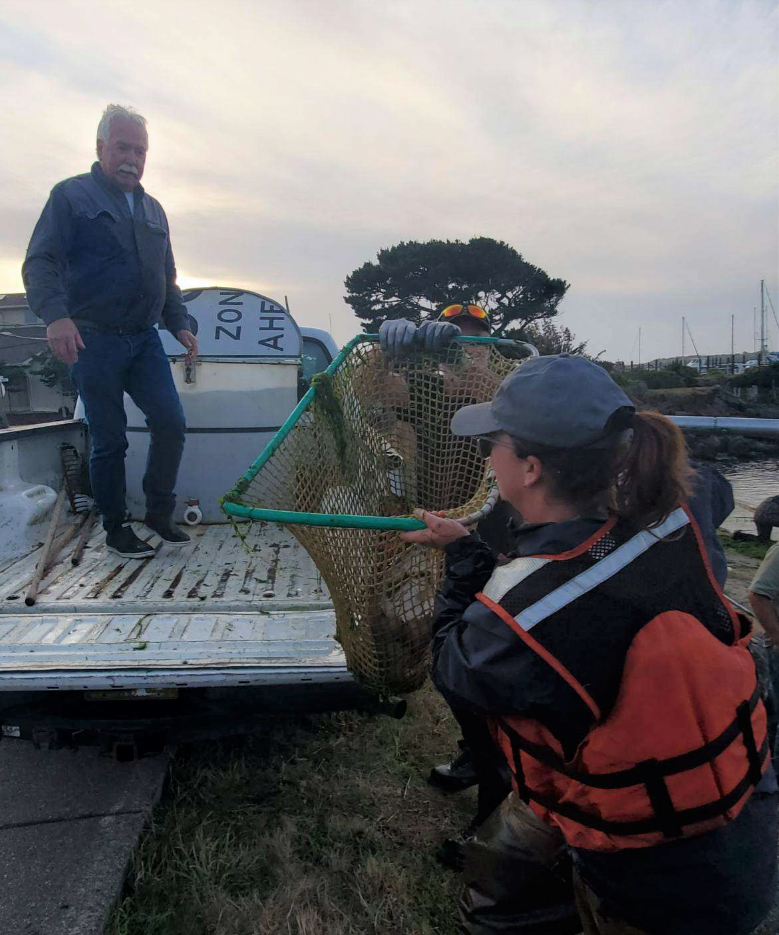Hatchery gets a boost
Tribe’s efforts aid Coquille River brood stock collection
BANDON – More than 500 hours of work paid off with an eightfold increase in the Bandon Hatchery’s 2021 collection of fall Chinook salmon brood stock.
In 2020, the state-owned hatchery secured only three breeding pairs of the iconic but increasingly scarce fish. With help from Coquille Tribal employees and community volunteers, the number rose to 24 pairs in 2021.
“This is something to celebrate,” said tribal Chairman Brenda Meade. “This is an accomplishment.”

The Coquille River’s fall run of Chinook salmon is an ancient and treasured resource for the tribe, but numbers of fish returning from the ocean have crashed in the past decade. After the Coquille Tribal Council declared an emergency this summer, the tribe partnered with the Oregon Department of Fish and Wildlife in a campaign to rescue the fishery.
The project missed the tribe’s goal of 70 breeding pairs, mainly because female salmon were in short supply. Many of the 88 captured males will die as bachelors. Helena Linnell, the tribe’s biological planning and operations manager, blamed the imbalance on “the luck of the draw.”
Still, 2021’s increased brood stock is encouraging. With 24 female fish averaging 3,400 eggs each, the hatchery will produce dramatically more juvenile fish – known as “smolts” – than in recent years.
Photo: Tribal biologist Helena Linnell helps hoist a newly netted salmon to the waiting hands of Tribal Council member Don Garrett. He’ll put the fish in a tank for transport to the hatchery.
To make that possible, tribal staff members and community volunteers spent long hours in and on the river. They herded and netted adult salmon, they worked alongside ODFW’s hatchery staff, and they “electrofished” for invasive predators, to create a more hospitable home for smolts.
With 2021 finished, the tribe’s attention has turned to 2022.
Salmon hatch in rivers but mature at sea, returning as adults to spawn and die. Linnell said 2021’s efforts focused on “harvest augmentation” – breeding and releasing more hatchery-produced smolts. Doing so yields more adults for tribal members and sportsmen to catch, but it doesn’t restore the native population of wild fish.
The tribe advocates a more ambitious agenda in 2022 and beyond, including long-term enhancement of upstream habitat for wild salmon to spawn and smolts to grow.
Habitat enhancement means lowering water temperature and reducing sediment, by planting trees and altering agricultural practices. Those goals depend on the cooperation of willing landowners, but even incremental changes would be a “gigantic” step, Linnell said.
More electrofishing is also on 2022’s agenda. Electrofishing uses a specially equipped boat to shock invasive smallmouth and striped bass, so that they can be scooped up and eliminated. The more bass are killed, the more smolts can survive to adulthood.
Linnell emphasized that salmon restoration requires collaboration among state and local agencies, private organizations and the public. Meade expressed gratitude to the many groups and individuals who have stepped up as community partners.
“We have had tremendous outreach from the community,” Meade said.
To make a difference for future generations of fish and humans, those efforts will need to continue.
